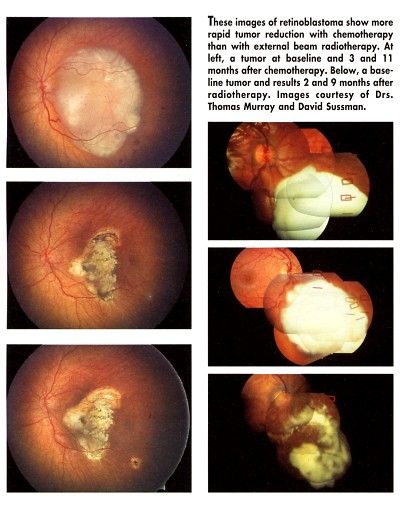Globe-Sparing Therapy for Retinoblastoma Is Increasing
FORT LAUDERDALE, Florida-Current conservative management of pediatric intraocular retinoblastoma is very effective, especially with chemotherapy plus focal ablation of tumors. But enucleation remains the primary therapeutic choice in children, undertaken in almost three quarters of cases, investigators reported at the Association for Research in Vision and Ophthalmology (ARVO) annual meeting.
FORT LAUDERDALE, FloridaCurrent conservative management of pediatric intraocular retinoblastoma is very effective, especially with chemotherapy plus focal ablation of tumors. But enucleation remains the primary therapeutic choice in children, undertaken in almost three quarters of cases, investigators reported at the Association for Research in Vision and Ophthalmology (ARVO) annual meeting.
Timely diagnosis and treatment of retinoblastoma, which occurs in one in 23,000 live births, have contributed to a marked improvement in patient survival. Therapeutic strategies have evolved considerably, and current modalities include enucleation, external beam radiotherapy, scleral plaque radiotherapy, transpupillary thermoablation, cryotherapy, laser ablation, and chemotherapy.
A series of 461 cases retrospectively evaluated over 3 decades shows that enucleation rates have declined considerably, from 96% in the 1970s to 73% today, due to earlier diagnosis and effective conservative therapy, reported John A. Epstein, MD, of the Wills Eye Hospital, Philadelphia (abstract 2588).
According to the Reese-Ellsworth classification of disease severity (size, location, and number of tumors; presence of seeding), enucleation in Dr. Epstein’s series was performed on 84% of stage V patients, but only 38% of stage IV, 20% of stage III, 6% of stage II, and 0% of stage I patients. Eyes with vitreous seeding only were commonly enucleated (76%), while those with subretinal seeding were less commonly enucleated (49%) and often treated with chemoreduction (36%), Dr. Epstein reported.
The management of unilateral retinoblastoma, therefore, varies considerably depending on many factors. To prevent metastasis, aggressive treatment is often necessary in patients whose disease is obviously severe and threatening, but a skilled and insightful treatment team can often spare the globe in some patients with advanced disease, Dr. Epstein’s and other reports from the ARVO meeting suggested.
"These days you can have good results even in advanced stages without enucleation," he said. "But at some point, you reach a threshold. You can’t treat all patients conservatively."
Chemoreduction vs Radiotherapy
The success of a conservative approach in a select population of advanced patients was clearly demonstrated in a study led by Thomas Murray, MD, professor of ophthalmology and radiation oncology, Bascom Palmer Eye Institute, University of Miami (abstract 2590).
David Sussman, MD, who is now a resident at Jackson Memorial Hospital, presented results of this retrospective review of 26 eyes in 26 infants and young children with stage IV and V retinoblastoma undergoing globe-conserving therapy at the eye center.
Patients received systemic chemoreduction with carboplatin (Paraplatin), vincristine, and etoposide, with or without cyclosporine, every 3 weeks for seven cycles (69% of patients). For the radiotherapy patients (31%), the researchers utilized a relative lens-sparing technique with single daily fractionation to a total dose of 4,320 to 4,500 cGy. Adjunctive therapy included local ablative transpupillary diode laser therapy (38%) and/or cryotherapy (8%).
Although efficacious, radiotherapy has been associated with a number of complications, which has generated a shift in primary treatment from radiotherapy to chemotherapy. Chemotherapy is not exempt from complications, of course, and this study compared the two approaches for efficacy in tumor control. At mean follow-up of 36 months, survival in the whole study group was 100%, the globe conservation rate was 100%, and no patient developed metastases. Therefore, both approaches achieved excellent outcomes in these patients.
The reduction in tumor volume, however, was much more rapid after chemotherapy/focal ablation than after radiotherapy (see Figure). This effect was observable as early as the first follow-up visit, Dr. Sussman said.

"It is important to get a faster response with regard to tumor shrinkage. The earlier you treat these tumors, the more the retina can adapt, because of the plasticity of the visual system," he said.
Radiotherapy is now generally reserved for patients in whom chemotherapy has failed to control the disease, the investigators noted.
The children in this study, with advanced-stage disease, were selected for globe-conserving therapy on the basis of Dr. Murray’s clinical judgment, Dr. Sussman noted. "Dr. Murray felt he could treat them and save the globe and preserve vision, and this was possible in 100% of patients."
The mechanism of action by which chemoreduction achieves a more rapid tumor response, compared with radiotherapy, appears to be through cell apoptosis, Dr. Murray said.
In a transgenic mouse model of retinoblastoma (virtually identical to human retinoblastoma), his group showed that giving serial subconjunctival carboplatin injections, which produces prolonged sustained delivery of the drug, resulted in an increase in intratumoral apoptosis and a decrease in tumor size over time (abstract 2593).
"We have been very interested in delivering focal chemotherapy, because that eliminates toxicity and myelosuppres-sion," Dr. Murray said. "We inject into the subconjunctival periorbital space, and the drug diffuses across the eye. Using a standard injection regimen, we had a 10- to 40-fold increase in apoptosis over controls."
This response is both dose-dependent and time-dependent after drug delivery, he said, explaining that the apoptosis increases as the serial injections proceed, about every 72 hours. This fits with what is clinically observed in treating these tumors, he pointed out.
"When you compare radiotherapy, which used to be the gold standard, to chemotherapy, the new gold standard, the eyes respond differently. Eyes treated with chemotherapy respond more rapidly, and these data suggest it is because the apoptosis induction is faster with chemotherapy," Dr. Murray said.
Newsletter
Stay up to date on recent advances in the multidisciplinary approach to cancer.
Elevating the Quality of Cancer Care via Cross-Department Collaboration
Experts from Sibley Memorial Hospital discuss how multidisciplinary work has enhanced outcomes such as survival and resource use at their institution.